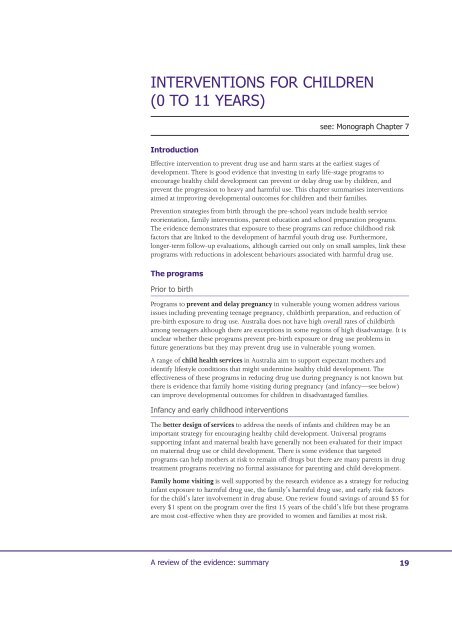Summary - Department of Health and Ageing
Summary - Department of Health and Ageing
Summary - Department of Health and Ageing
You also want an ePaper? Increase the reach of your titles
YUMPU automatically turns print PDFs into web optimized ePapers that Google loves.
Effective intervention to prevent drug use <strong>and</strong> harm starts at the earliest stages <strong>of</strong><br />
development. There is good evidence that investing in early life-stage programs to<br />
encourage healthy child development can prevent or delay drug use by children, <strong>and</strong><br />
prevent the progression to heavy <strong>and</strong> harmful use. This chapter summarises interventions<br />
aimed at improving developmental outcomes for children <strong>and</strong> their families.<br />
Prevention strategies from birth through the pre-school years include health service<br />
reorientation, family interventions, parent education <strong>and</strong> school preparation programs.<br />
The evidence demonstrates that exposure to these programs can reduce childhood risk<br />
factors that are linked to the development <strong>of</strong> harmful youth drug use. Furthermore,<br />
longer-term follow-up evaluations, although carried out only on small samples, link these<br />
programs with reductions in adolescent behaviours associated with harmful drug use.<br />
<br />
<br />
Programs to prevent <strong>and</strong> delay pregnancy in vulnerable young women address various<br />
issues including preventing teenage pregnancy, childbirth preparation, <strong>and</strong> reduction <strong>of</strong><br />
pre-birth exposure to drug use. Australia does not have high overall rates <strong>of</strong> childbirth<br />
among teenagers although there are exceptions in some regions <strong>of</strong> high disadvantage. It is<br />
unclear whether these programs prevent pre-birth exposure or drug use problems in<br />
future generations but they may prevent drug use in vulnerable young women.<br />
A range <strong>of</strong> child health services in Australia aim to support expectant mothers <strong>and</strong><br />
identify lifestyle conditions that might undermine healthy child development. The<br />
effectiveness <strong>of</strong> these programs in reducing drug use during pregnancy is not known but<br />
there is evidence that family home visiting during pregnancy (<strong>and</strong> infancy—see below)<br />
can improve developmental outcomes for children in disadvantaged families.<br />
<br />
The better design <strong>of</strong> services to address the needs <strong>of</strong> infants <strong>and</strong> children may be an<br />
important strategy for encouraging healthy child development. Universal programs<br />
supporting infant <strong>and</strong> maternal health have generally not been evaluated for their impact<br />
on maternal drug use or child development. There is some evidence that targeted<br />
programs can help mothers at risk to remain <strong>of</strong>f drugs but there are many parents in drug<br />
treatment programs receiving no formal assistance for parenting <strong>and</strong> child development.<br />
Family home visiting is well supported by the research evidence as a strategy for reducing<br />
infant exposure to harmful drug use, the family’s harmful drug use, <strong>and</strong> early risk factors<br />
for the child’s later involvement in drug abuse. One review found savings <strong>of</strong> around $5 for<br />
every $1 spent on the program over the first 15 years <strong>of</strong> the child’s life but these programs<br />
are most cost-effective when they are provided to women <strong>and</strong> families at most risk.

















